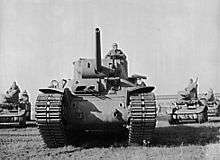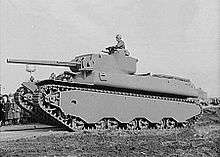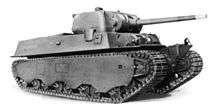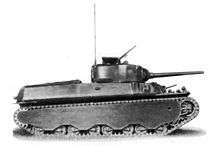M6 heavy tank
| Heavy Tank M6 | |
|---|---|
|
T1E1 prototype | |
| Type | Heavy tank |
| Place of origin | United States |
| Service history | |
| In service | trials only |
| Used by | United States Army |
| Wars | WWII |
| Production history | |
| Designer | US Army Ordnance Corps |
| Manufacturer | Baldwin Locomotive |
| Number built | 40 |
| Variants | 6 |
| Specifications (M6) | |
| Weight | 126,500 lb (57.4 tonnes) combat loaded |
| Length | 27 ft 8 in (8.43 m) gun forward |
| Width | 10 ft 3 in (3.12 m) over track armor |
| Height | 9 ft 10 in (3.0 m) to turret roof |
| Crew | 6 (commander, gunner, driver, assistant driver, loader, assistant loader) |
|
| |
| Armor | 25–83 mm |
Main armament |
1 × 3in (76.2 mm) gun M7 (75 rounds) 1 × 37 mm (1.46 in) gun M6 (202 rounds) |
Secondary armament |
2 × .50 cal (12.7mm) Browning M2HB machine guns, hull (6,900 rounds) 2 × .30 Browning M1919A4 machine guns, one fixed (bow), one flexible AA (5,500 rounds) |
| Engine |
1,823 in3 (29.88 L) Wright G-200 9-cylinder gasoline 825 hp at 2,300 rpm |
| Power/weight | 15.7 hp/tonne |
| Transmission | Timken mechanical model 16001, three speeds (two forward, one reverse); rear drive sprocket |
| Suspension | Horizontal volute spring |
| Ground clearance | 20.5 in (52 cm) |
| Fuel capacity | 477 US gallons (1,810 L) |
Operational range | 100 miles (160 km) |
| Speed | 22 mph (35 km/h) |
The Heavy Tank M6 was an American heavy tank designed during World War II. The tank was produced in small numbers and never saw combat.
Development
Because of limited budgets for tank development in the interwar years, at the outbreak of World War II the US Army possessed few tanks, though it had been keeping track of the use of tanks in Europe and Asia. Successful employment of armored units in 1939–40, mostly by the Germans, gave momentum to a number of US tank programs, including a heavy tank program. The United States possessed a massive industrial infrastructure and large numbers of engineers that would allow for mass production of tanks.
Following the Chief of Infantry recommendation from 20 May 1940, the US Army Ordnance Corps started to work on a 50-ton heavy tank design. Initially a multi-turreted design was proposed, with two main turrets armed with low-velocity T6 75 mm (2.95 inch) guns, one secondary turret with a 37 mm gun, and a coaxial .30 caliber (7.62 mm) machine gun, and another secondary turret with a 20 mm gun and a coaxial .30 caliber machine gun. Four .30 caliber machine guns were to be installed in ball mounts, two in the glacis (front) plate and two in the rear corners of the hull. The project was approved on 11 June 1940 and the vehicle received the designation Heavy Tank T1. The design was somewhat similar in concept to multi-turreted breakthrough tanks developed in Europe in the 1920s and throughout the 1930s, such as the 1925 British Vickers A1E1 Independent or the Soviet T-35 of the early 1930s. Disadvantages of these "land dreadnoughts", namely their excessive size, difficulty in coordinating actions of the crew, and high production costs, led to abandonment of the concept in Europe.


By October, the US developers reached the same conclusion as their European counterparts. The armament was changed to a single vertically stabilized 3-inch (76.2 mm) gun and a coaxial 37 mm gun in a single three-man turret with both manual and electric traverse. The turret had a commander's cupola identical to that of the M3 Medium Tank. Additional armament consisted of two .50 caliber machine guns in a bow mount (operated by the assistant driver), two .30 caliber machine guns in the front plate (fired electrically by the driver), one .30 caliber in the commander's cupola and one .50 caliber in a rotor mount for anti-aircraft use in the right rear of the turret roof (operated by the loader). The crew consisted of commander (seated in the turret left), gunner to the right of the gun, gun loader (turret), driver and assistant driver in the front left and right of the hull respectively, and another crewman in the hull to pass ammunition to the turret.
One of the main challenges was developing a powerpack for such a heavy vehicle. The Wright G-200 air-cooled radial gasoline engine was selected by a committee formed by the Society of Automotive Engineers, but no suitable transmission was available. The committee recommended developing a hydramatic transmission, while a possibility of using a torque converter or an electric transmission was also to be checked.
In 1941–42 three prototypes were built by the Baldwin Locomotive Works, one with electric transmission and two with torque converter transmission. Variants with hydramatic transmission were never completed. The prototypes also differed in hull assembly method – one had welded hull and two cast hull. On 26 May 1942 two variants with torque converter transmission were standardized as M6 and M6A1. Standardization of the electric transmission equipped T1E1 as M6A2 was never approved, but manufacturing of the vehicle was nevertheless recommended. It was proposed by the Ordnance Corps that 115 T1E1s would be built for the US Army for "extended service tests", between that and Services of Supply instruction to increase production with the balance going to aid US allies, this would mean 50 M6s and 65 M6A1s built for the British.[1] The production started in December 1942.
Some minor changes were introduced in the production vehicles: the cupola was replaced by a double-door hatch with a ring mount, the machine gun in a rotor mount and the left front machine gun were removed.
However, by the time the M6 was ready for production, the Armored Corps had lost interest in the project. The advantages the M6 offered over medium tanks – its much thicker armor and slightly more powerful gun – were offset partly by the shortcomings of the design – such as very high silhouette, awkward internal layout and reliability problems – and partly by logistical concerns due to its weight.
In early 1942 the Ordnance Department set a production target of 250 a month, with Fisher as a second contractor to meet a planned expansion in the size of the army.[2] However, by September the focus had changed, with tank production scaled back and more aircraft for the USAAF. Under this new "Army Supply Program", the M6 production was cut from 5,000 to a little over 100.[2]
By the end of 1942, the Armored Corps were of the opinion that the new M4 Sherman gave adequate solution for the present and the near future, while being reliable, cheap and much easier to transport and they had no need for a heavy tank. In 1943 the production target was reduced again, down to 40,[2] being an economic cut-off.[3]
Production M6 and pilot M6A1 examples were evaluated at Fort Knox in the early part of 1943. The reports were critical of the awkward and inefficient crew stations and the superfluous 37mm gun.[4]
The Ordnance Corps had expected the 75 mm gun to be lacking, and the T1E1 prototype was tested with a T7 90 mm gun and was found to be a satisfactory gun platform, although poor turret layout was noted again. By this point the M6 had been cancelled.[5]
In August 1944 the Ordnance Corps recommended modifying the T1E1s to build 15 specially armored and armed tanks to meet a need for attacking heavily fortified areas. These 77-ton vehicles – designated M6A2E1 – with thicker (equivalent to 7.5-inch (190 mm) vertical protection) glacis armor and a turret developed for the T29 Heavy Tank, armed with a T5E1 105 mm gun but no increase in engine power. Ordnance believed they could be delivered by November. The proposal was put to the supreme commander in Europe General Eisenhower, who rejected them as impracticable. Two tanks were used to test the T29 turret and gun, but their armor was not modified.[6]
However, by late 1942 main development effort shifted to other projects, one of which eventually resulted in the M26 Pershing.
On 14 December 1944 the M6 was declared obsolete. Only forty units were produced and they never left US soil. Several toured the United States for propaganda purposes, where they gave performance displays (such as car crushing) at War Bond drives and the like. All were eventually scrapped except for a single T1E1 which was put on display at the United States Army Ordnance Museum, Aberdeen, Maryland.
The British used the suspension of the M6 in the first of their two A33 Heavy Assault Tank "Excelsior" prototypes.
Variants



- T1 – Cast hull, hydramatic transmission. Never built.
- T1E1 – Cast hull, General Electric electrical transmission.[7] Standardization proposed as M6A2 but not accepted. 20 units built.
- T1E2 / M6 – Cast hull, torque converter transmission. 8 units built.
- T1E3 / M6A1 – Welded hull, cast turret, torque converter transmission. 12 units built.
- T1E4 – Welded hull, hydramatic transmission. Four GM engines.[7] Cancelled 1942. Never built.
- M6A2E1 – Uparmored T1E1 fitted with a new turret with a T5E1 105 mm gun. Used for testing T29 heavy tank project armament system.
See also
- G-numbers
- M-numbers
- TOG II* – British superheavy prototype tank for trench warfare
- T29 – late-war prototype heavy tank; early version turret and gun was tested on M6A2E1 variant
Tanks of comparable role, performance and era
- British Excelsior – prototype heavy tank, two built, did not enter service
- British Churchill – heavy tank, entered service in 1941
- American-British T14 – prototype heavy tank with similar specifications
- Soviet KV-1 – heavy tank, entered service in 1939
Contemporaries to M6A2E1 variant
- German Tiger II – late-war heavy tank, entered service in 1944
- British Centurion Mark 5/2 – post-war main battle tank with 105mm cannon
- French ARL 44 – produced and served in limited numbers in the late 1940s and early 1950s
- French AMX 50 – several prototypes produced in the late 1940s and early 1950s
- United States T26E4 "Super Pershing" heavy tank – single prototype M26 Pershing with extra armor and improved gun; fought in Western Europe during 1945
- Soviet IS-2 model 1944 – heavy assault tank, entered service in 1944
- Soviet IS-3 – heavy tank, entered service in 1945, did not see combat
Notes
References
- Chamberlain, Peter; Ellis, Chris (1969), British and American Tanks of World War II, Arco Publishing
- R.P. Hunnicutt – Firepower: A History of the American Heavy Tank, 1988 Presidio Press, ISBN 0-89141-304-9.
- Heavy Tank M6 at AFV database
- Icks, Robert J. (1971), No. 32: The M6 Heavy and M26 Pershing, AFV Weapons, Profile Publishing
External links
| Wikimedia Commons has media related to M6 Heavy tank. |
